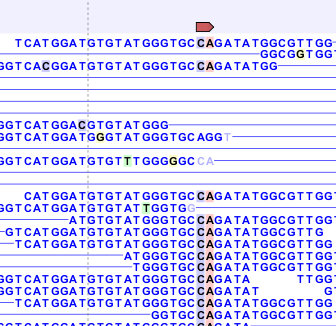Merging adjacent variants
Multi-Nucleotide-Variants (MNVs) are by definition variants of length >=2,
which are present in the same allele. They can be identified by
investigating if two or more SNVs are adjacent and supported by the same sequencing reads.
It is important to report them together in the output of the variant caller to
report the correct functional consequences in the downstream analysis (e.g. determining the correct amino acid change).
Figure 26.16 shows an example where two SNVs are merged to one.

Figure 26.16: Two adjacent SNVs merged into one MNV.
Both SNVs were present in the same sequencing reads, leading to the conclusion that they are present in the same allele. The CLC Genomics Workbench reports these SNVs as one MNV in order to evaluate the potential combined effect on the translation to protein.
Furthermore, the frequency of the MNV reflects the number of reads in which the MNV (= both SNVs) are found together. SNVs are only joined to one MNV, if they are next to each other and if they are linked in at least one sequencing read. Otherwise SNVs will be reported separately.
